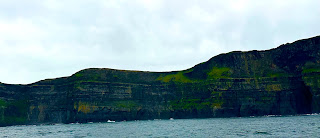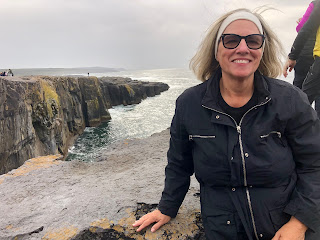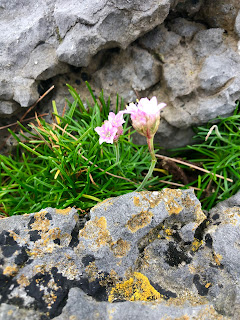We assembled at 9:00am this morning to begin our full day guided tour of the Galway Bay area. It was a combination of small van, medium sized boat, and small horse and buggy.
Beginning in the harbor area of Galway city, we went west along the northern coast of Galway Bay into the Connemara region. Outside of town the landscape becomes very rugged. The small farms are divided into defined lots and pastures by rock walls. These walls are different from the many walls we saw in the east and south of Ireland. The walls in Connemara are called ‘dry’ walls because there is no grout between the rocks. According to our tour guide, this construction method helps prevent the high winds in the area from blowing down the walls. The wind simply blows through the cracks. It also allows the farmers to herd their livestock from pasture to pasture by simply taking down a portion of the wall and restacking it again.
Our launch point for the first boat ride was near the village of Rossaveel. We boarded the 200 passenger ferry and headed south to Inis Oirr, the southern most of the Aran Islands in Galway Bay.
It was a balmy day (by Irish standards) with winds at about 20mph, 3 to 4 foot seas, and air temperature at around 65F. I was glad I took my motion sickness pills before we began the 90 minute trip.
Inis Oirr is one of the smallest Aran Islands. Population is approximately 218 persons. There is a 15th century castle on the highest part of the island.
We, along with the other people in our tour group, had seafood chowder for lunch at the ‘hotel’ tavern on the island when we arrived. While eating, we were entertained by a local resident drinking at the bar, who spontaneously broke out into an a cappella version of a ribald Irish folk tune.
After lunch, we hired a horse and buggy driver to take us around the island. The buggy was much more roomy than the Gap of Dunloe rig. The roads here are narrow and twisty, and are lined with stacked rock walls. It gives you the impression of riding through a series of chutes. On the windward side, we saw the remains of a shipwrecked cargo vessel dating from the 1960’s. Its cargo of lumber was lost in the wreck, but all 11 crewmen were saved.
When we finished our tour of the island, we boarded another, larger ferry boat. On our first ride, we sat in the open air on the top deck. This time, the only seats available were on the enclosed lower deck near the bow.
On this leg of the boat ride, we had to cross some open water between the North Atlantic Ocean and Galway Bay. By this time of day, the wind was picking up and the seas had increased to some larger swells. Once we hit the open water, we started a rollercoaster ride of asymmetrical ups and downs. Up in the bow this motion was enhanced.
Suddenly, and without warning, the woman seated next to Laura began spewing out her chowder lunch. I must say I have never seen Laura move so quickly as she bounded toward Paul and away from the torrent of soup on her opposite side. For a few minutes in the warm enclosed atmosphere of that lower deck, there was a real danger of a chain reaction of seasickness beginning. Fortunately, an experienced (but likely low-ranking) crew member arrived soon to open a door for ventilation and to swab the deck.
By this time, we were just off the coast of the famous Cliffs of Moher. The captain slowed the boat and let us bob around in the churning water to view the massive limestone cliffs. For those of you who’ve seen the film, ‘The Princess Bride’, you may remember Wesley climbing up the ‘Cliffs of Insanity’ to rescue Buttercup. That scene was filmed here.
A short while later, sanity for us passengers in the bow was restored when we landed at the dock near Doolin, in County Clare and got back onto dry land.
Our van picked us up and we headed north up the coast through the Burren region. This area is distinctive because of the karst, or limestone, topography that is created by thousands of years of erosion. The rock is cracked and there are lots of fissures and caves in the area. Colorful flowers and grass grow within the cracks.
We got back into Galway around 6:00pm and, with no advance reservations (on a Saturday night!) managed to get into the King’s Head Bistro (and pub) by 6:45pm for dinner. The pub is in a building that was originally the home of the first mayor of Galway in 1654. The warm fireplace is dated 1612.
The Latin Quarter was teeming with young people just getting started on Saturday night fun as we slightly older folks walked the couple of blocks to our hotel for the night.
NEXT: Rest day in Galway

















No comments:
Post a Comment